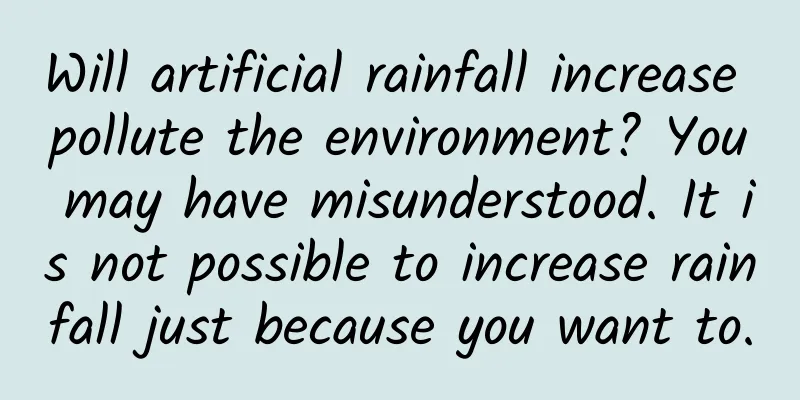Will artificial rainfall increase pollute the environment? You may have misunderstood. It is not possible to increase rainfall just because you want to.

|
During droughts, will relevant departments carry out artificial rainfall enhancement operations? When artificial rainfall enhancement operations are carried out, some people have some doubts about the operations... Regarding artificial weather modification, the public still has many cognitive misconceptions and misunderstandings. Misunderstanding 1: Can artificial rainfall be increased whenever we want? We often hear the term "artificial rainfall". In fact, from the perspective of meteorology, it should be artificial rainfall enhancement. The difference of one word makes a huge difference in meaning. Artificial rainfall cannot be carried out at any time. It cannot be achieved without clouds. However, not all clouds have precipitation potential. Only those cloud systems with rich water resources are worth developing and utilizing. Therefore, artificial rainfall is not made out of thin air. Certain meteorological conditions are required. Generally speaking, the thickness of the cloud layer must be greater than 2 kilometers. For cold clouds, there must be areas with rich supercooled water content in the clouds. Secondly, there must be precipitation weather processes, water vapor transport and updraft areas. Artificial weather modification mainly involves the spreading of catalysts on orographic clouds, convective clouds, layered clouds, cumuliform clouds and stratocumulus mixed clouds. When the meteorological department predicts that a local area will welcome a cloud cluster, it is necessary to choose the right time for the operation, the right location for the operation, and the right amount of catalyst to increase the size of cloud droplets and ice crystals to a certain extent, and guide the clouds to produce more precipitation as soon as possible. Therefore, artificial rainfall enhancement is a meteorological scientific work that requires the coordination of multiple factors such as "time" and "location" to carry out. Misunderstanding 2: Will catalysts cause environmental pollution? The catalysts used in artificial impact operations are mainly dry ice (solid carbon dioxide), liquid nitrogen, silver iodide, etc. These catalysts have a high ice-forming ability and only a small amount is needed for each operation. For example, the commonly used cold cloud catalyst, dry ice and liquid nitrogen vaporize into carbon dioxide and nitrogen - both are the main components of air, so they are all "ecologically safe catalysts" and will not pollute the environment. At present, the most commonly used catalyst in my country's weather modification business is silver iodide. Long-term monitoring has found that the amount of silver iodide used in weather modification operations is very small, and the concentration of silver ions accumulated in the water and soil in the operation area is far lower than the concentration specified by the World Health Organization. Therefore, the correct use of catalysts will not cause environmental pollution. Misunderstanding three: Will the rain downstream be “driven away”? In the case of large-scale precipitation, the water vapor in the clouds is constantly replenished, and the cloud system is constantly updated with the changes in the rising air currents. During each rainfall, the water vapor in the clouds is sufficient, and artificial catalysis mainly affects the clouds that have already formed, but the hydrometeors in the clouds are not large enough to fall off, so the impact of artificial catalysis on water vapor flux is minimal. In fact, beyond a certain distance, the cloud bodies that cause precipitation downstream are often not the cloud bodies that catalyze upstream. Cloud bands are composed of smaller cloud bodies that are constantly generated and renewed. They are not like river water, which is intercepted upstream and reduced downstream. In order to test the impact of artificial rainfall operations upstream of the weather system on the rainfall downstream of the weather system, scientists have conducted random artificial rainfall experiments in Australia, the United States, Israel, Switzerland and other places. Statistical results show that in the downwind area of the catalytic zone, precipitation increases just like in the catalytic zone. At present, there is no evidence that artificial rainfall in the upstream area will reduce precipitation in the downstream area. Of course, evaluating the effects of weather modification is also a global problem. With the development of large-scale weather modification operations, meteorological workers are paying close attention to the impacts that artificial rainfall enhancement and other methods may have on downstream weather systems, and are conducting further in-depth research. Produced by Guangdong Science and Technology Newspaper Media Center Gatekeeper expert | Guo Zeyong, senior engineer of Yangjiang Meteorological Bureau, Guangdong Province Editor | Tuo Yan |
<<: Sleeping with wet hair often will increase the risk of cancer? The truth is here
Recommend
Mocha AE post-production tracking basic tutorial
Mocha AE post-production tracking basic tutorial ...
2021 CPA Money-Making Project Training Camp, where beginners can earn 200-1000 yuan per day
2021 Hand-in-hand teaching you how to play the CP...
World Environment Day丨You may not have seen such a beautiful China
Today (June 5) is World Environment Day. In recen...
Drinking coffee actually has this effect? Good news for gout patients!
Drinking coffee actually has this effect? Good ...
Short video app “Tik Tok”: Will it become popular for a while and then die?
I wrote an article before about how the rapidly g...
Where is the future of new media operations?
A few months ago, a friend who works in new media...
Electric Technology Car News: With a size larger than Cayenne and more domineering than Land Rover, can Acura MDX top the mid-to-large SUV market?
Acura MDX has always been the flagship model in t...
Toutiao | Advertising Optimization Guide (Practical)
As one of the mainstream forms of mobile Internet...
Is goose down better than duck down? Don’t choose the goose over the duck when choosing down jackets!
Audit expert: Wang Lei National Parks and Conserv...
Vipshop’s live streaming IPization, what is the potential of “original video + shopping guide live streaming”!
The Olympic Games have just ended. In this Olympi...
The "Spring Limited" delicacies that you can't miss, take your taste buds on an outing!
Eat the taste of spring and enjoy the scenery of ...
Japan plans to negotiate with China to unify new energy vehicle charging system standards
According to Japan's Jiji Press, Japan is neg...
Explore the Xbox-related features on Win 10
As the previous generation of Windows operating s...
5.20 Programmer: The goddess is waiting for you to hook up
Disheveled, unkempt, wearing a backpack and flip-...









